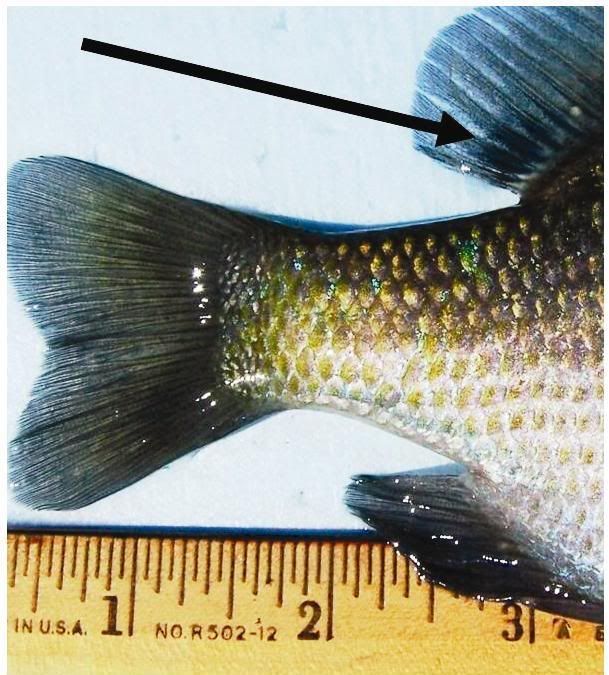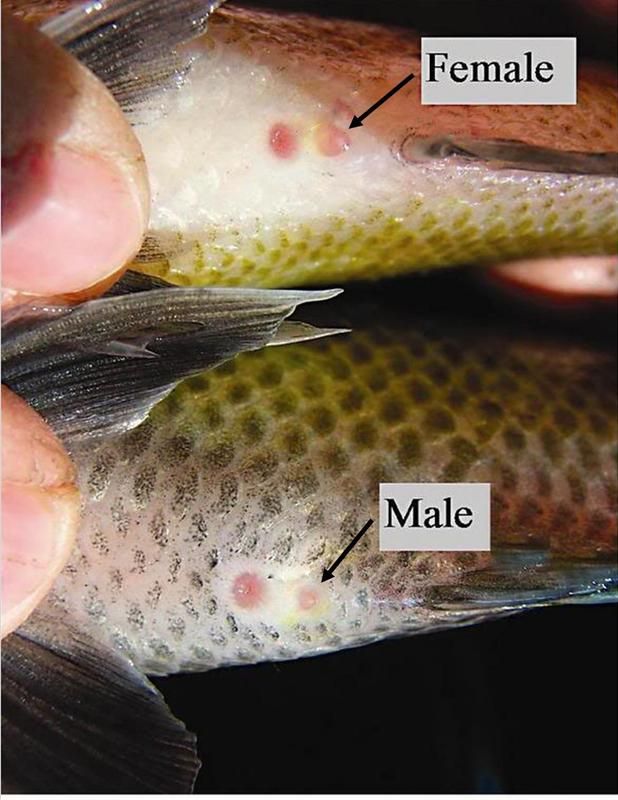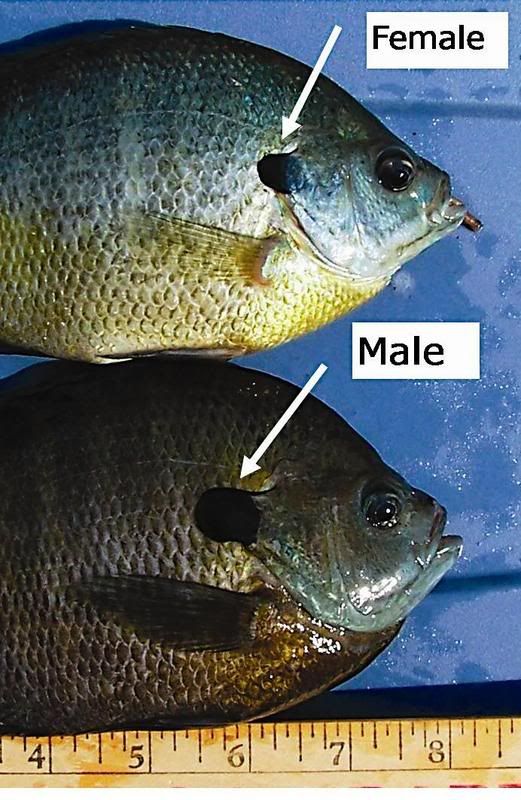Here's a couple of photos to help forum member in identifying bluegill by sex.
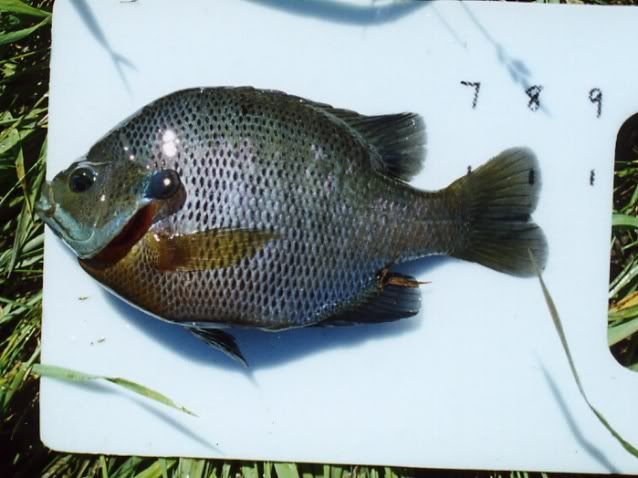
This fish was caught yesterday at my all-male bluegill pond. Note the extremely good body condition due to lack of competition and availability of artificial feed. This fish has a large ear flap or ear tab, black in color and extended posteriorly (tailward). Vivid coloration and burgundy colors on breast. Lots of black tips on scales.
Here's a mature female bluegill. It's a large mature fish that is also pellet fed. Much shorter ear tab, yellowy colored breast. No black spots on side scales.
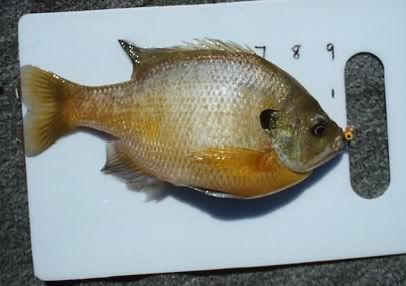
Now here's where it gets a little tricky. This is a smaller fish but is still a mature female with eggs. Still has a short ear tab and yellow coloration on breast.
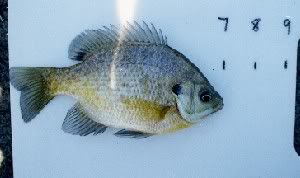
But this is a mature, smaller male bluegill that may be acting as a "sneaker" or "cuckholder". The coloration is much more drab, the ear tab isn't as big, but he can't quite hide the slightly longer ear tab.
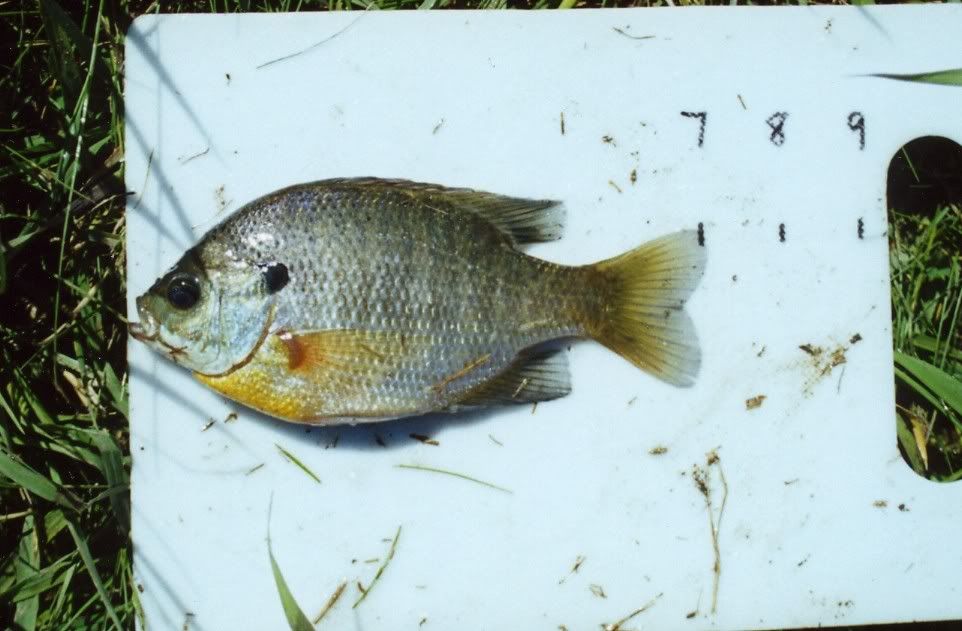
This fish was verified as a male shortly before I ate him. He is using the muted color and smaller stature to be able to hang around Mr. Big Boy's nest without being attacked. When the female moves in to lay the eggs he sneaks out of the weeds and "provides a little genetic information".
Bruce,
Excellent pictures! Did you verify that the cuckholder is actually a male by the black scales? I see some black scales up high up the side of the fish behind the head.
Not trying to disagree with you but isn't that a little big for a cuckholder? Could it have actually been an immature male or one that just has not gotten into the spawning mode yet? Just asking.
I verified him with the "filet knife" method. Yeah, he could be an immature male that just reached seven inches so fast that he didn't mature yet, or because he's around so many big, dominant males. I think in a typical pond a cuckholder might be more likely to be five to six inches, but in the pond this one was caught at there are tons of really big, robust 8-10 inch males.
I like your observation about the black spots, though. I hadn't noticed it until you brought it up, but there they are!
The pond I caught him in yesterday had other males of similar length that were very vivid in color and seemed ready to spawn.
Bruce,
Makes sense.
Are your pond temps coming up yet? We had a hard frost again this morning and I think we are suppposed to have another one tomorrow morning although daytime highs are going up every day from now on.
I was fishing my pond and a friend's pond yesterday and the water temps were a miserable 49 degrees. We've been in the 20's or 30's for lows for like seven straight days now. I'm trying to arrange a bluegill fishing outing this afternoon.
Great pictures and excellent info! Thanks, Bruce.
I'm trying to decide if I want to print these out and laminate them, so I can put them in my tackle box and reference them over and over at the pond. I definitely want to use this info to help decide whether a BG goes back in the water or into the deep fryer.
What Bruce has done here is fail to put the unit of measure on his plastic board.
Come on now Bruce! Those are centimeters right?
Just kidding.
Sunil, I recognize that board from the horse business. It's marked off in hands.

Very nice pictures Bruce ! Years ago Bill Cody sent me similar ones thru e-mail...but his were a lot smaller

Eastland,
Yep, Bill's are never as big as he says they are! Take those perch he was watching through the ice.

:p
Right, Theo.
...and horses are a little easier to identify by sex as well, aren't they?
I've never needed pictures with horses, descriptions alone have always been sufficient.
Cattle are even easier.
Bruce :
Great post . What more can one ask for in a post : beautiful { and large} BG , outstanding info and a learning experience . I was aware of the dark vertical bars on BG , the coloration and ear flaps but I did not know to look for the black tip on the scale of the males . The male only BG pond is interesting . Keep us posted on the results.
I occasionaly catch what I think is a BG/RE cross which I assume was a mistake due to muddy water conditions during the spawn or a confused BG cuckholder. I will try to post a photo next time I catch one. If anyone has seen or heard of a BG/RE cross let us know.
What about coloration outside of the spawn ? The BG seem to be more silver and less colored . From watching BG in my aquarium the color is much less vivid outside the spawn. The BG also change color based on conditions like stress , anger, fear. They get much darker when these conditions exist. Thanks -- ewest
A friend of mine, Don Gabelhouse, who is Nebraska's fisheries chief has told me that muddy conditions during the spawn do, indeed promote hybridization of lepomis species.
BG/RES hybrids do occur sometimes in the wild. I think I actually have one in one of my small ponds. My guess is that they grow pretty big if they have appropriate forage.
Both male and female bluegill have more vivid coloration in clear water. Sometimes after a big runoff event, and the subsequent clouding of the water, our bluegill will turn almost silver in color due to turbidity.
Also, stragely enough, bluegill that are transported in dark colored containers are brighter on arrival than those transported in white containers.

Cecil, I checked on cuckholder size and my "source" says that the sneaker males are smaller than cuckholders. A sneaker uses his small size to create opportunity and a cuckholder uses his drab color to do the same.
Hey Bruce!
Due to the Illustrated Condello Method I was able to sex the BG I caught tonight - it matched up quite well with your cuckholder/immature male description and picture (he's now in the freezer awaiting company).
I would probably be posting the picture of this trophy 6 3/4" BG, but my Webmaster is in Washington, D.C. on his 8th grade class trip.
Thanks again for all the info!
You're welcome! Sometime I'd like to get a few more male bluegill photos on to show fish in between that 7 in. cuckholder and the big 8+ inch dominant male.
Bruce :
Thanks for the additional info on BG/RE cross. I think you are correct in your assessment that they may get large. We catch about 1 or 2 of these crosses a year.
In our ponds the RE appear to spawn twice { march and april full moon if temp. is ok} while the BG spawn 4 or 5 times { april-aug.}. Sometimes the april spawn is accompanied by heavy rain/muddy water. I think this is the cause of the crosses. All of the crosses I have seen/caught were about 50 % larger than the large BG in the pond. Most were in the 12 inch/ 1.5 lb range. One in particular looked like a dinner plate { 13 in. and 2+ lbs.}. It was the largest lepomis I have seen. However it was not even close to the state {Miss.) records for BG {3.45 lbs }or RE {3.33 lbs.}. The coloration on all was similar and what you would expect from a BG/RE cross - mixed up and with characteristics of both. Silver/pale green with muted BG colors , no verticle bars but with a BG ear flap and body shape , but spotted pattern like a RE. I did not check to see if any had the mouth { crusher } of a RE.
Thanks -- ewest
Your description of the hybrid is EXACTLY what mine looks like. I've also found that RES seem to spawn on the next deeper shelf or tier than the BG. When I'm fishing pits that have both during the spawn I'll catch the male BG in spawning colors at a certain shallow depth and I'll catch the male RES in spawning colors a little deeper.
Bruce,
This is exactly what I was looking for.
Thanks
Courtesy of Mr. Greg Grimes a photo showing male vs. female differences of both BG and RES.
Males on the bottom and females on top.
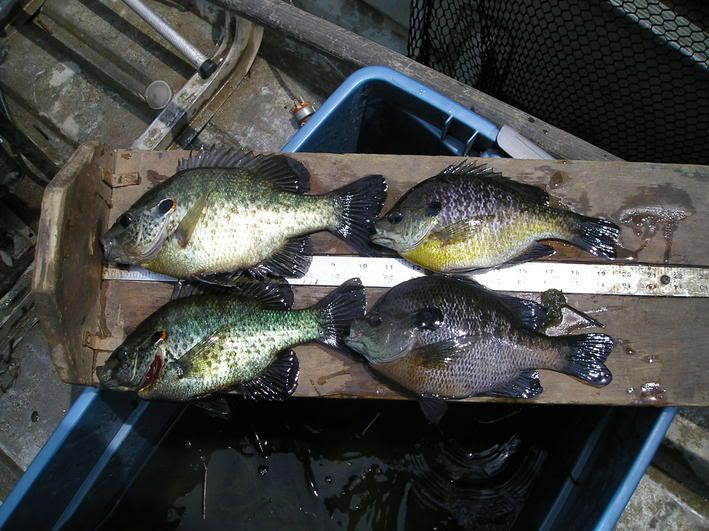
Both males are on the bottom, I believe.
I know you are correct on the bluegill...and I THINK you are correct on the redears.

I agree on the BG. Not so sure on the RES. If the top RES is female it is the biggest one , at 10.5 inches that I have seen and that much larger than the male RES and BG male. Not sure about the color on the op. flap both orange ? CB1 and I had this dicussion before -- red on the male , orange on female .I never heard this until CB1 provided it and I later found a LA state fisheries web site that said the same thing. The underside of the top RES is lighter which makes me think female , but not much color. Isn't this fun !!! I just wish I was better at it.

I will do some checking and post what I find.
Checking :
Texas web site
http://www.tpwd.state.tx.us/huntwild/wild/species/sunfish/ The species' most distinct characteristic is the red edge on the opercle ("ear") flap of the male (orange on the female).
Fla. site
http://images.google.com/imgres?imgurl=h...6lr%3D%26sa%3DN Males and females are similar in appearance, although the male is generally more colorful.
Aub. pict.
http://images.google.com/imgres?imgurl=h...3D %26sa%3DN U Mic.
http://images.umdl.umich.edu/cgi/i/image...start=1;resnum= ...back edge of opercular flap with red border in male, orange in female; no wavy lines on cheek 3 anal spines.
I would say both of these are male but look at color/shade difference.
http://images.google.com/imgres?imgurl=h...6lr%3D%26sa%3DN
I could be wrong, and maybe Greg will chime in, but I think the top redear is carrying eggs.
Bruce :
Does the female BG look like it has eggs to you? If the top RES is female and carrying eggs ( sure looks fat) then based on time of year so should the female BG. At 9 inches and assuming in the south the BG should be of spawning age, my guess 2 to 3 yrs old. Greg how about some more info on these 2 pairs and the location and time of year.
Carrolton, GA. I think early May 2005. Both tops are female and yes Ewest she had eggs. THis is how I knew it was female and wanted a pic to look back on. Thanks BC for posting.
I have seen a few red flaps on what I thought were females. Plenty of orange ear flaps on what I thought were males. Little easier to diff BG with some pratice.
Dear Dr. Condello,
Are you still a part-time dentist?? Your knowledge of the Centrarchidae family continues to impress me.
Aaron Klusmire
Originally posted by Aaron Klusmire:
Dear Dr. Condello,
Are you still a part-time dentist??
ROTFLMAO!!!



Aaron, that struck me as incredibly funny. If it was intentional, keep up the good work. If it was unintentional, you've got the gift of accidental humor, and God has Blessed those around you.
To Aaron,
Hey, listen up buddy! I just got done working FIVE grueling hours. Don't give me a hard time!
To anyone who doesn't know Aaron, here's a sample of what his entire life is like.
Caller: Hello, My name is Mr. such-n-such. I heard you work on ponds.
Aaron: Yes I do. How can I help you?
Caller: I have a farm pond in the middle of my corn field and I have too much moss. Can you get rid of the moss and make it clear like the lake I saw in Colorado last year?
Aaron:...uh...well...
Caller: And by the way, I only have twenty dollars to spend.
Aaron: I don't think that....
Caller: And the pond is only two feet deep.
Aaron: Cht-cht-cht-chchch-cht. (That's Aaron chattering like a raccoon).
Merry Christmas,
...and a happy male bluegill.
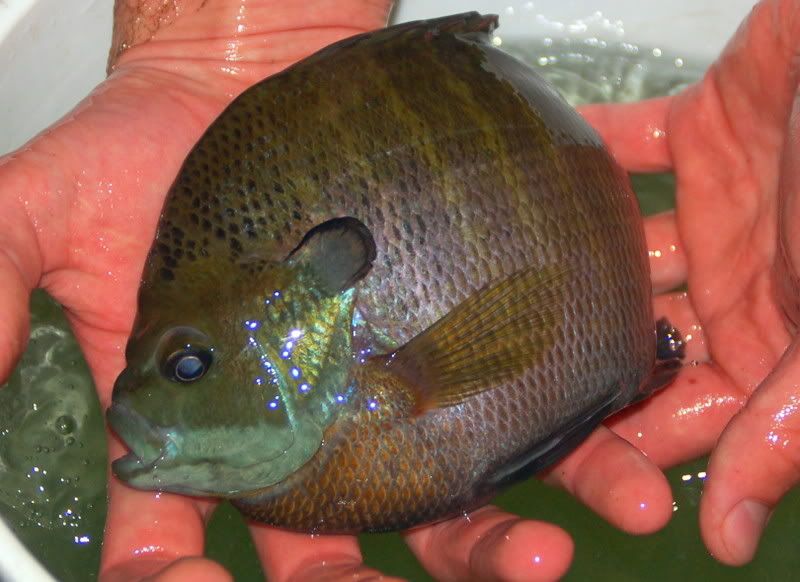
I think I posted this before. Doesn't this female packed with eggs look like it should be a male by coloration at first glance? It came out of a stained water pond and the angler told me all the fish are darker in color in this pond.
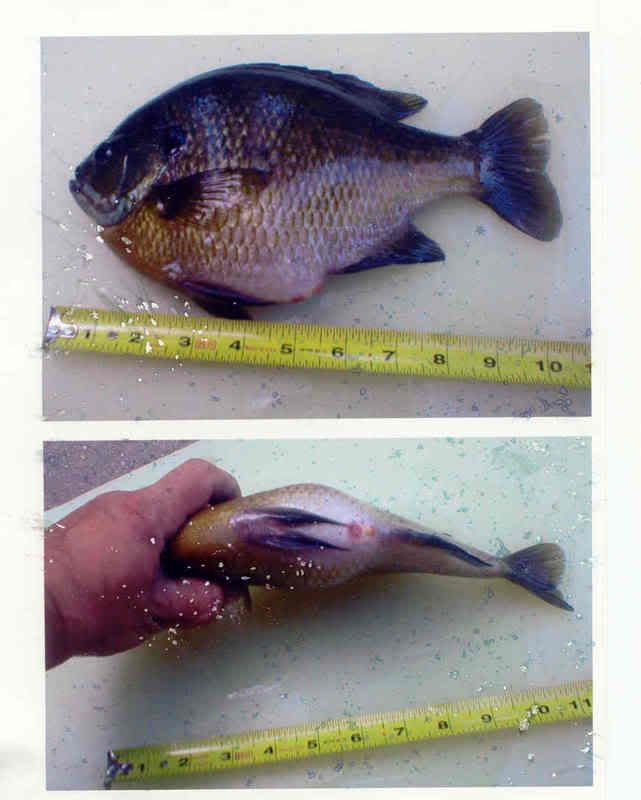
Exemplary gravid female BG shape, Cecil.
The coloration is certainly vivid enough to seem like a mature male (which is probably why you and Bill and Bruce state that one must have a feel for the local BG population's coloration scheme before sexing them successfully). I can't see the opercule very well because she is so dark, but I notice that she has no shoulders, helmet, or breast plate the way I would expect a male BG of that large size to exhibit. So you have to consider all the evidence, don't you?
Yes you do. You have to be really careful.
Bobby Glennon a biologist for Malone and Sons told me they are very careful when culling fish by sex. He says if they can't actually get gametes from the fish (milt and eggs) they don't do any guesses no matter how educated.
I know this spring when I plant my brood gills I will be using a catheter and probing for gametes along with all the visual characteristics.
I know this spring when I plant my brood gills I will be using a catheter and probing for gametes along with all the visual characteristics.
I'm not sure but I think that is illegal in several states. And you guys wonder why some Blue Gills bite your nipples. After this type of invasion to privacy I think that you are lucky that they are only biting your nipples.
I'm beginning to think that there may be something to all of those alien abducting/probing stories that you see on TV. Perhaps the aliens are just trying to be certain whether or not they are catching male or female humans. Well at least they are using catch and release practices.
And as for Bruce, I lost a lot of respect for him when he posted the photo above. Oh sure he can raise huge BG, but did he have to breed the tail right off of them. What kind of fishing sport is that???
Ok, I'll go back to my cage now.
[quote=Cecil Baird1]I know this spring when Oh sure he can raise huge BG, but did he have to breed the tail right off of them. What kind of fishing sport is that???
Unless he is crossing BG with mola mola...
[quote=Cecil Baird1]I know this spring when Oh sure he can raise huge BG, but did he have to breed the tail right off of them. What kind of fishing sport is that???
Unless he is crossing BG with mola mola...

And what good is breeding bluegills that are permanently curved like that? I had to put each bluegill I got from Bruce in a vise to straighten them out, and super glue on a tail! Thank God as a taxidermist I have lots of spare parts!



Here's a really nice example of male scale-tipping in a young bluegill.
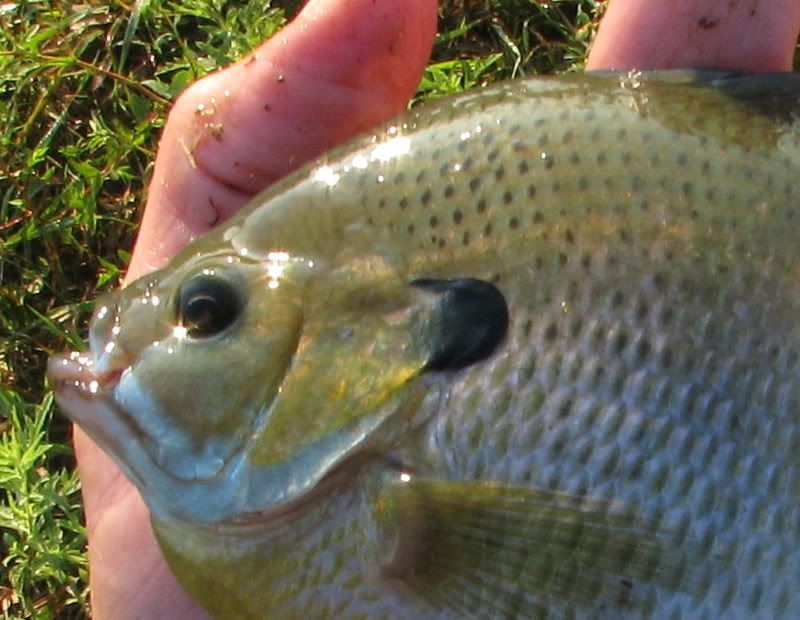
You have to be really careful.
Bobby Glennon a biologist for Malone and Sons told me they are very careful when culling fish by sex. He says if they can't actually get gametes from the fish (milt and eggs) they don't do any guesses no matter how educated.
This even goes for chickens. Earlier this year I bought 10 one-day-old "sexlink" pullets (females) from a reputable chicken dealer. A "sexlink" is a mix between two varieties of chickens that supposedly makes sex identification very reliable. Wrong!
(In my case, these were the offspring of white rock hens and Rhode Island red roosters.)
When they hatch, foot color and feather color are supposed to reliably identify their sex. They sure all looked the same to me.
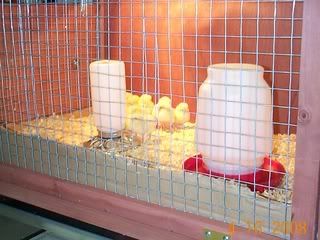
When they were about a week old, I thought that one female was kind of dominant. At about two weeks old, I thought she was kind of masculine. At about four weeks old, I introduced the young ones to my older ones. They knew -- I still wasn't sure.
At about five weeks there was no mistaking the young cockerel for a pullet. He really changed colors and markings.

Are fish much different?
At least with bluegill I get lots of practice finding out if I was right or wrong. The filet knife is a good verification device.


I would say that the fish in the photo is 99+% certain of being a male, but I wholeheartedly agree with you that you can never be absolutely sure!
At least with bluegill I get lots of practice finding out if I was right or wrong. The filet knife is a good verification device.


I would say that the fish in the photo is 99+% certain of being a male, but I wholeheartedly agree with you that you can never be absolutely sure!
And this is why I may be going to all fish cages for production for my niche market. It may have other advantages too such as no wasted energy in spawning and they won't get beat up making the beds.
Although I religiously sexed the gills this year before releasing them into the big pond, I had some bluegill reproduction in the pond albeit a very small amount. I suspect I may have missed a puddle when I drained down the pond last year and rotenoned, but I'm not 100 percent sure.
When Theo posted that female bluegill with the black scale tipping that sent a shiver up my spine!

And can we say with 100 percent certainty that there is even a remote chance that a very small percentage of bluegills could change sex or be a hermapahrodite as in other fish species?
At least with bluegill I get lots of practice finding out if I was right or wrong. The filet knife is a good verification device.


I'm glad to know I'm not the only fish autopsy kook. For more than 50 years I've been looking way too close at fish innards, teeth, fins, scales, etc., and it isn't even my job.
If it was somebody besides Bruce or me, I'd tell them they need a new hobby and/or a therapist.
Based on your experiences Cecil, I think that it is much more likely that you or others will make a mistake in sexing BG or stocking than the chances are one will have a change sex or be a hermapahrodite! I menioned to you earlier how one managed to get out of a live box for me. Luckly I was able to fish him/her out of the pond with a piece of worm and tiny hook.
At least with bluegill I get lots of practice finding out if I was right or wrong. The filet knife is a good verification device.


I'm glad to know I'm not the only fish autopsy kook. For more than 50 years I've been looking way too close at fish innards, teeth, fins, scales, etc., and it isn't even my job.
If it was somebody besides Bruce or me, I'd tell them they need a new hobby and/or a therapist.
At least you're not a taxidermist!
Based on your experiences Cecil, I think that it is much more likely that you or others will make a mistake in sexing BG or stocking than the chances are one will have a change sex or be a hermapahrodite! I menioned to you earlier how one managed to get out of a live box for me. Luckly I was able to fish him/her out of the pond with a piece of worm and tiny hook.
Yep based on my luck that's for sure! Shoot you loose one out of the cage am immediately catch it again!
Interestingly not the same thing but I read in some scientific literature that polyploid bluegills are not that uncommon in a natural setting and may be why some grow so large.
great thread - learned a lot, ty!
Is it easier to figure their sex while they are smaller? Because i have some colorful and some plain color BG's. I think maybe the colorful ones are males. (They are 4-5 months old by the way)
Faith , BG are more difficult to sex when they are smaller and immature.
What kind (Northern, Coppernose, etc.) of BG are being sexed. When it comes to the male side, you can, and more often than not do have more than one functional type of male and they complicate sexing based on looks alone.
Be assured this is not a strictly academic concern so I am hardcore when it comes to sexing BG because messing up gets expensive.
Focusing on Northern BG;
Dorsal spot is not a reliable indicator as is has more to deal with mental state that is generally independent of reproduction.
Urogenital opening works when females mature. Opening I am concerned with is the most posterior as I am not not able to sex a fish based on appearance of the poop. Expressing gametes is better. The yellow coloration of male's vent area works best on the first type of male below.
Northern BG males come in three flavors with different names according to who you are talking to. First is bull / primary / nest building that has the large opercular tab, dark spots on nape and sometimes dorsal part of flank as well as a generally blackish cast ventrally. Such males can possess solid bars on flanks. This variant most people will pick up off nest or out of raceway and call a male with little hesitation. Second differs first by having a smaller opercular tab and less developed black spots. Solid bars can also be present. This variant can be confused from a distance, especially when keying in on opercular tab and sooty look of the first type. This dude looks like a lady and seldom makes a nest and when he does has a hard time sticking with it. The third type is small like a juvenile without taking on pattern of either female or male. These guys sneak into nest and drop a load when female is extruded eggs with the first type of male doing most of the work.
Northern BG females have a freckling pattern on flanks, generally smaller opercular tabs that can occasionally be larger than those of the second male type, and generally a yellowish belly early in breeding season. As breeding season progresses, actively spawning females start to look silvery as pigments are depleted as they are invested in eggs.
Jim, there seems to be more confusion about sexing BG than just about any other topic here. We'd love to see pictures if you have time at some point in the future. It is intriguing that there are 3 distinct males and at least 2 patterns for females. No wonder we study so many pictures of BG on this forum and always find it so hard to decide male or female.
We first must get bet beyond using the term BG as like not distinguishing a LMB from a SMB and a SB.
I have been working with wild stocks from all over. Northern BG are pretty consistent no matter where you get them from. Coppernose BG really mess things up and I am still trying to figure out Han-paint BG. The some of the Coppernose BG stocks are very different from each other as well making so generalizing not so easy. I have messed with what I think were Southwestern BG which are very similar to Northern BG but not enough to say much with confidence. Give me time to work up pictures which may take more than a year.
The BG clan is almost as much fun as the LES clan.
I think sexing LMB is much harder than Northern BG when there is no milt/eggs present.
When I'm sexing Northern BG, I go by the rule of thumb that if I'm not 100% sure it's a female then I consider it a male.
Same for a male. If I'm not 100% sure then all bets are off. I also agree with Jim, don't even start going down the hybrid or different species Bluegill path in regards to male/female.
Here on the forum I consider "BG" to be synonymous with Northern pure strain Bluegill.








